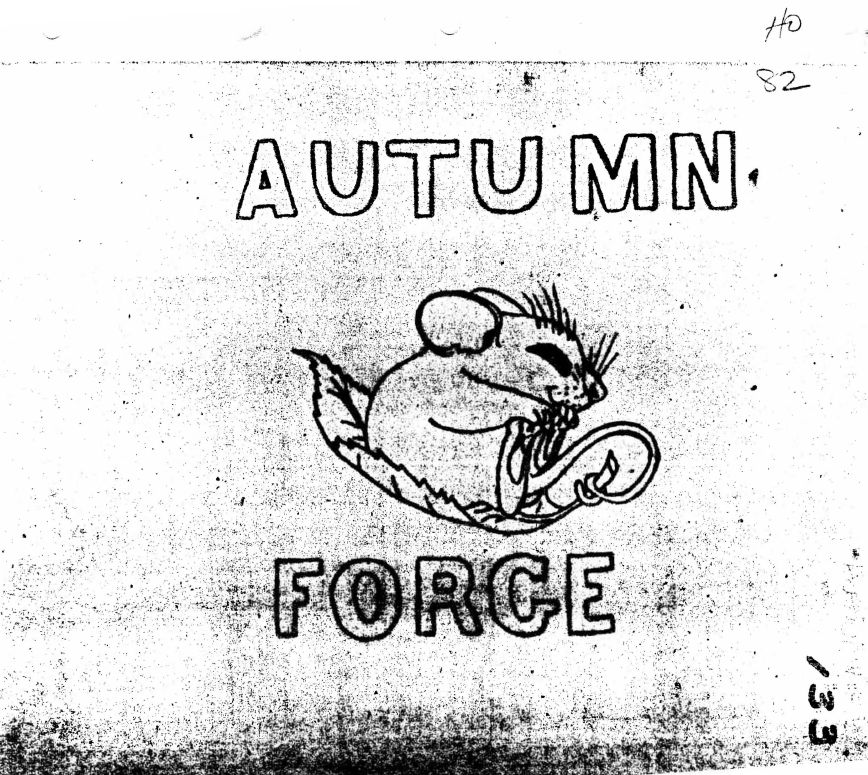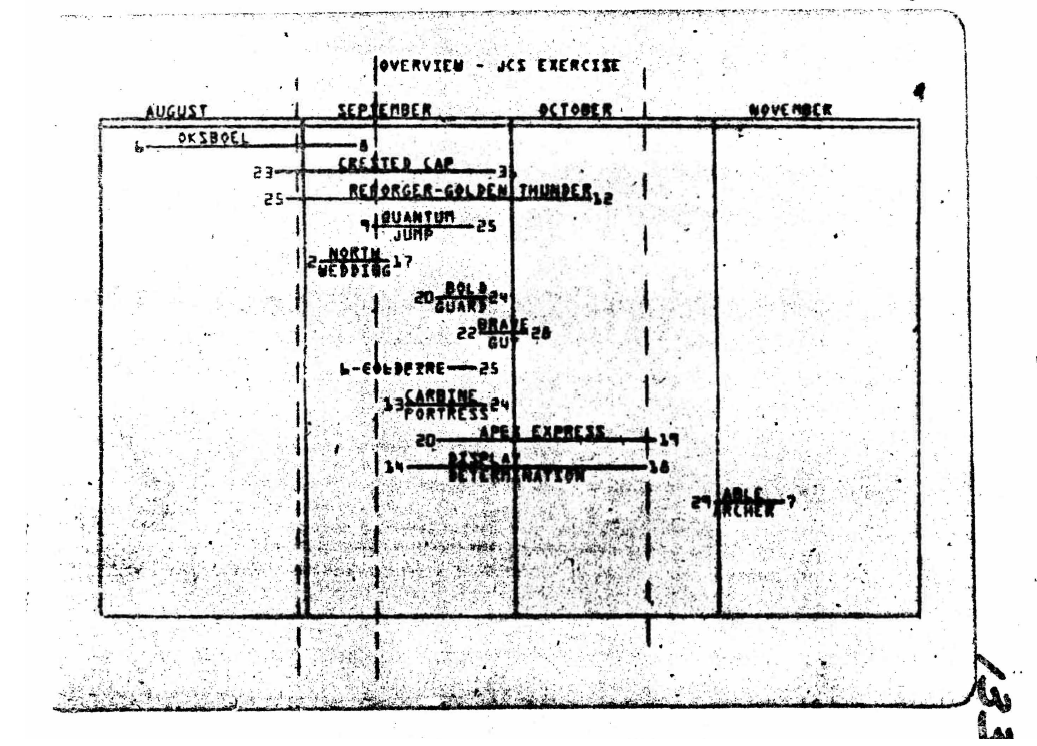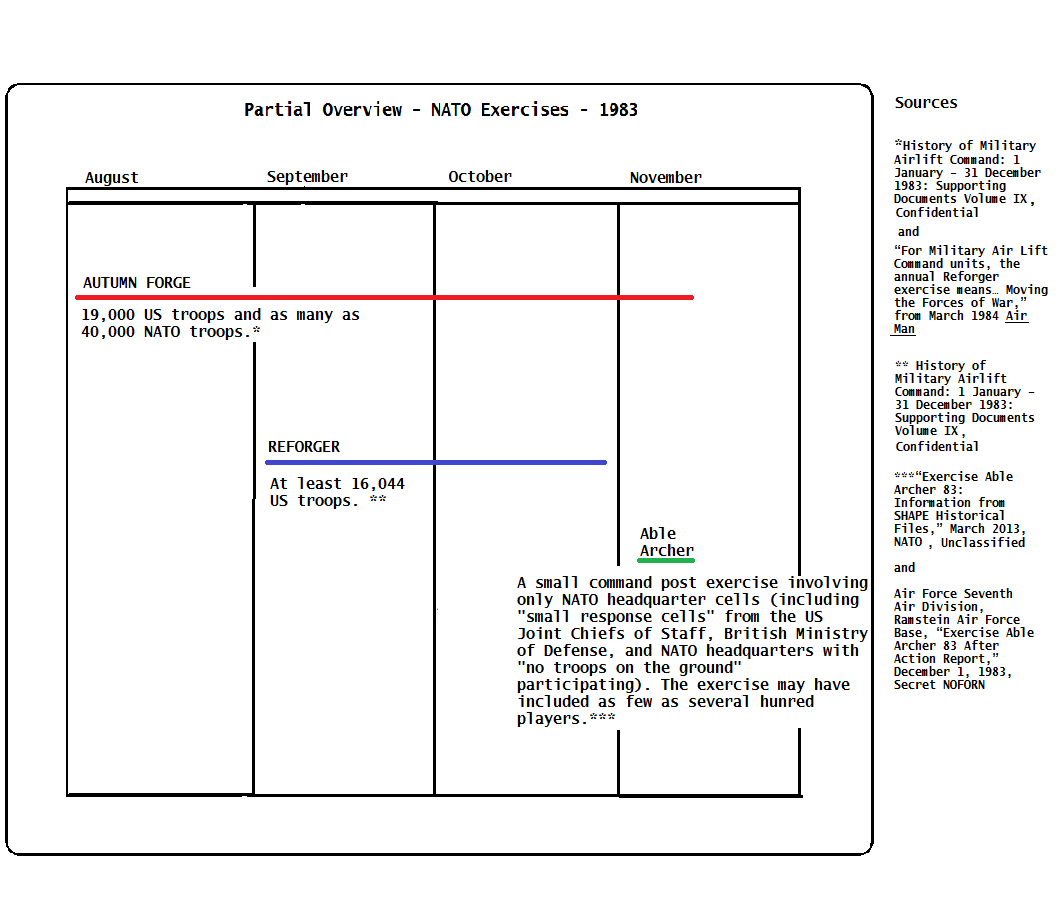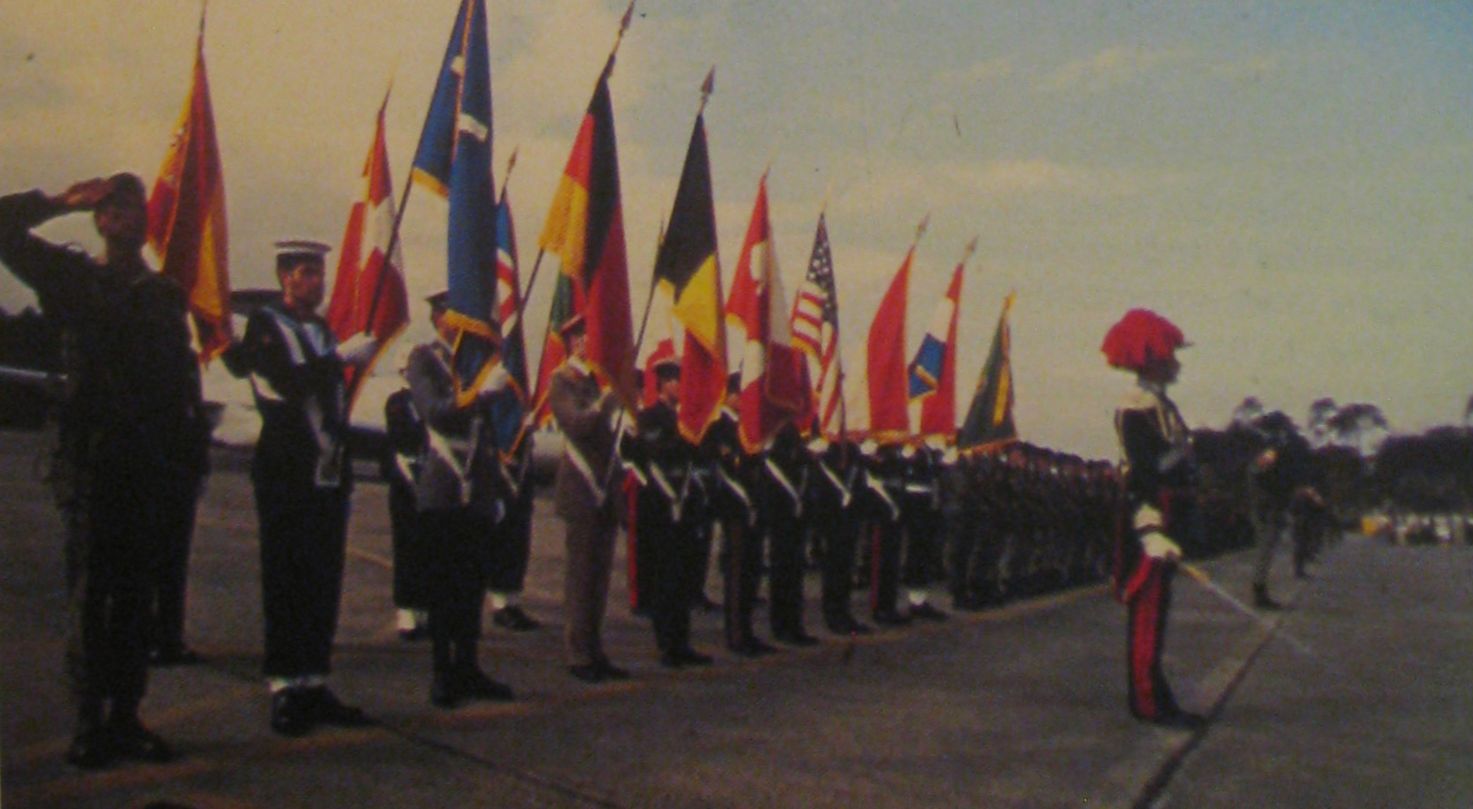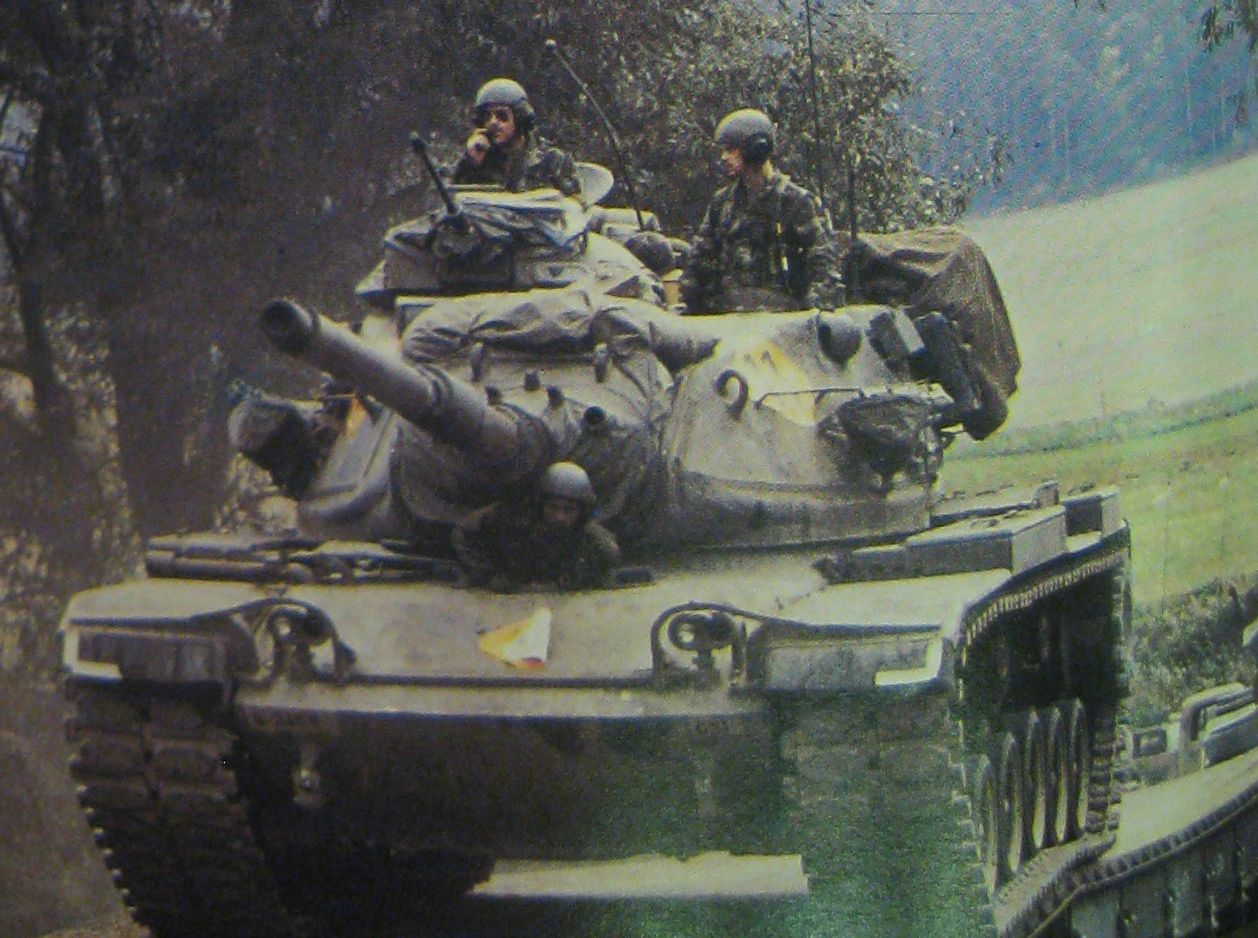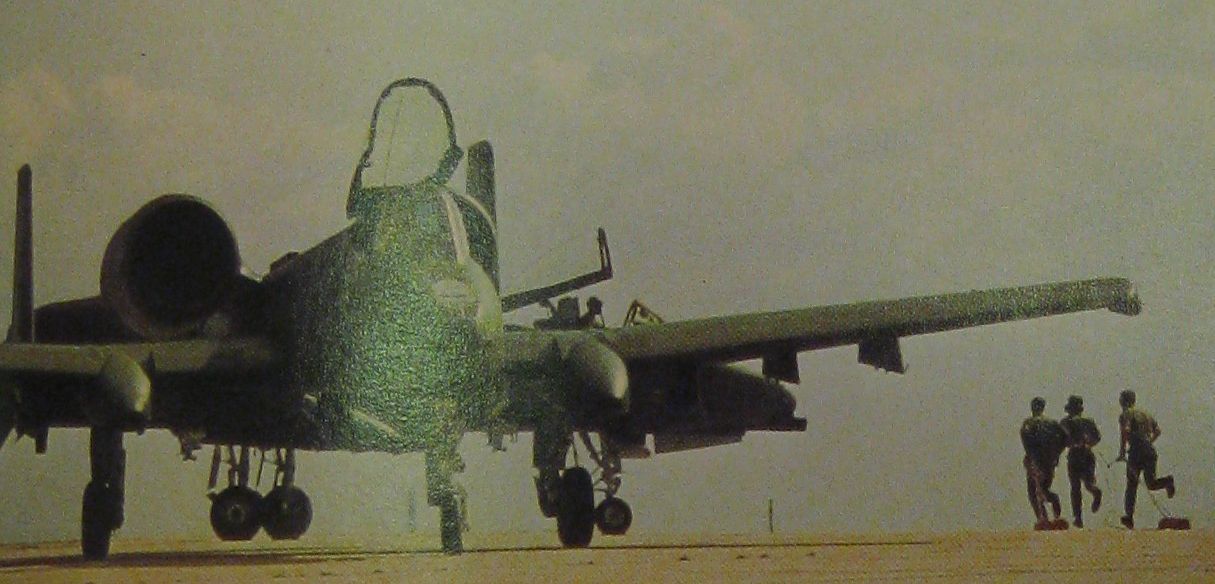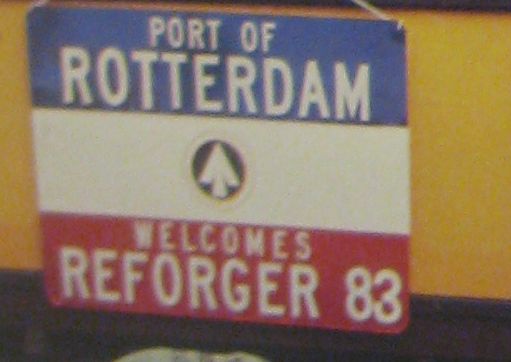View the updated Able Archer 83 Sourcebook Page for the latest documents and analysis on Able Archer 83.Related LinksNew Documents Reveal How a 1980s Nuclear War Scare Became a Full-Blown Crisis The USSR and US Came Closer to Nuclear War Than We Thought War Scare Nate Jones and Robert Farley Discuss Able Archer 83 The 1983 War Scare, Part III The 1983 War Scare, Part I
Launch on Warning: The Development of U.S. Capabilities, 1959-1979 Thirtieth Anniversary of NATO's Dual-Track Decision The 3 A.M. Phone Call
|
Nate Jones describes the second War Scare posting. Washington, D.C., May 21, 2013 – The NATO nuclear release exercise at the heart of the 1983 War Scare included at least four new components that differed from previous "routine" exercises, according to detailed, newly declassified chronologies of Able Archer 83, posted today by the National Security Archive ( www.nsarchive.org). The Able Archer controversy has featured numerous descriptions of the exercise as so "routine" that it could not have alarmed the Soviet military and political leadership. Today's posting reveals multiple non-routine elements, including: a 170-flight, radio-silent air lift of 19,000 US soldiers to Europe, the shifting of commands from "Permanent War Headquarters to the Alternate War Headquarters," the practice of "new nuclear weapons release procedures," including consultations with cells in Washington and London, and the "sensitive, political issue" of numerous "slips of the tongue" in which B-52 sorties were referred to as nuclear "strikes." These variations, seen through "the fog of nuclear exercises," did in fact match official Soviet intelligence-defined indicators for "possible operations by the USA and its allies on British territory in preparation for RYaN" — the KGB code name for a feared Western nuclear missile attack (Raketno-Yadernoye Napadenie).[1] To mark the 30th anniversary of the War Scare, the National Security Archive is posting, over three installments, the most complete online collection of declassified US documents, material from the Russian archives, and contemporary interviews on the 1983 War Scare. An earlier posting examined the debate over whether the Soviets were genuinely fearful of a Western nuclear attack or were "just huffing and puffing." This Electronic Briefing Book draws from an unpublished official NATO summary of Able Archer 83, declassified Air Force histories and after-action reports, and a previously unpublished interview with Soviet Chief of Staff Marshal Akhromeyev in which he calls European-wide NATO exercises "the most dangerous." The new material suggests that, during the dangerous year of 1983, when Soviet and US relations were at their nadir, Able Archer 83 included new quirks that made it provocative enough to increase the chance of nuclear war "through miscalculation." Today's posting includes:
THE DOCUMENTS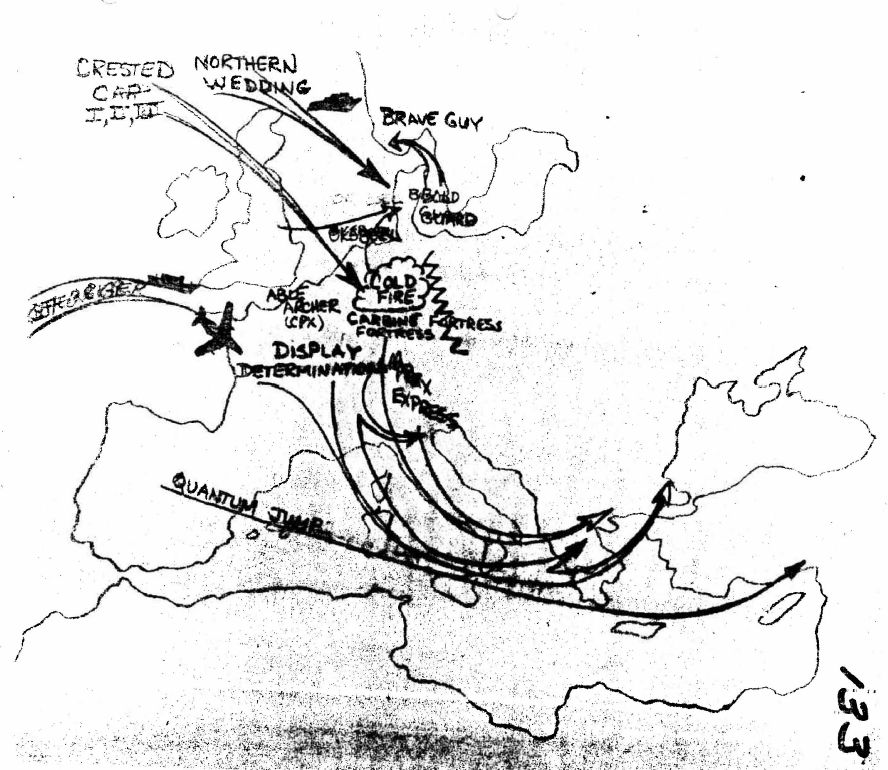 A slide from the unclassified September 9, 1983, commander airlift forces briefing shows the expansive "footprint" of the Autumn Forge war games. Document 1: "Autumn Forge 83 - Comalf [commander airlift forces] Briefing," September 9, 1983, Unclassified. Source: History of the 322nd Airlift Division, January 1982 - December 1983, Volume VII Supporting Documents, Prepared by Edgar P. Sneed, Division Historian, Unclassified. Released under the Freedom of Information Act (FOIA). Slides from Autumn Forge 82 show the "umbrella" nature of that annual maneuver. Autumn Forge 82 had 24 exercises conducted "beneath" it from August 6 1982 to November 7, 1982, which spanned the European continent. (An illustration of an umbrella — and a mouse "foraging" — are even included in the slides.) Able Archer 82 was the final exercise of the Autumn Forge 82 series; the same pattern occurred the next year. The slides indicate that the objectives of Autumn Forge 82 were to "Demonstrate solidarity of NATO committed forces," "conduct military operations in Europe with necessary C3 systems,[2] " and "familiarize external reinforcements with NATO doctrine, war plans, and procedures."
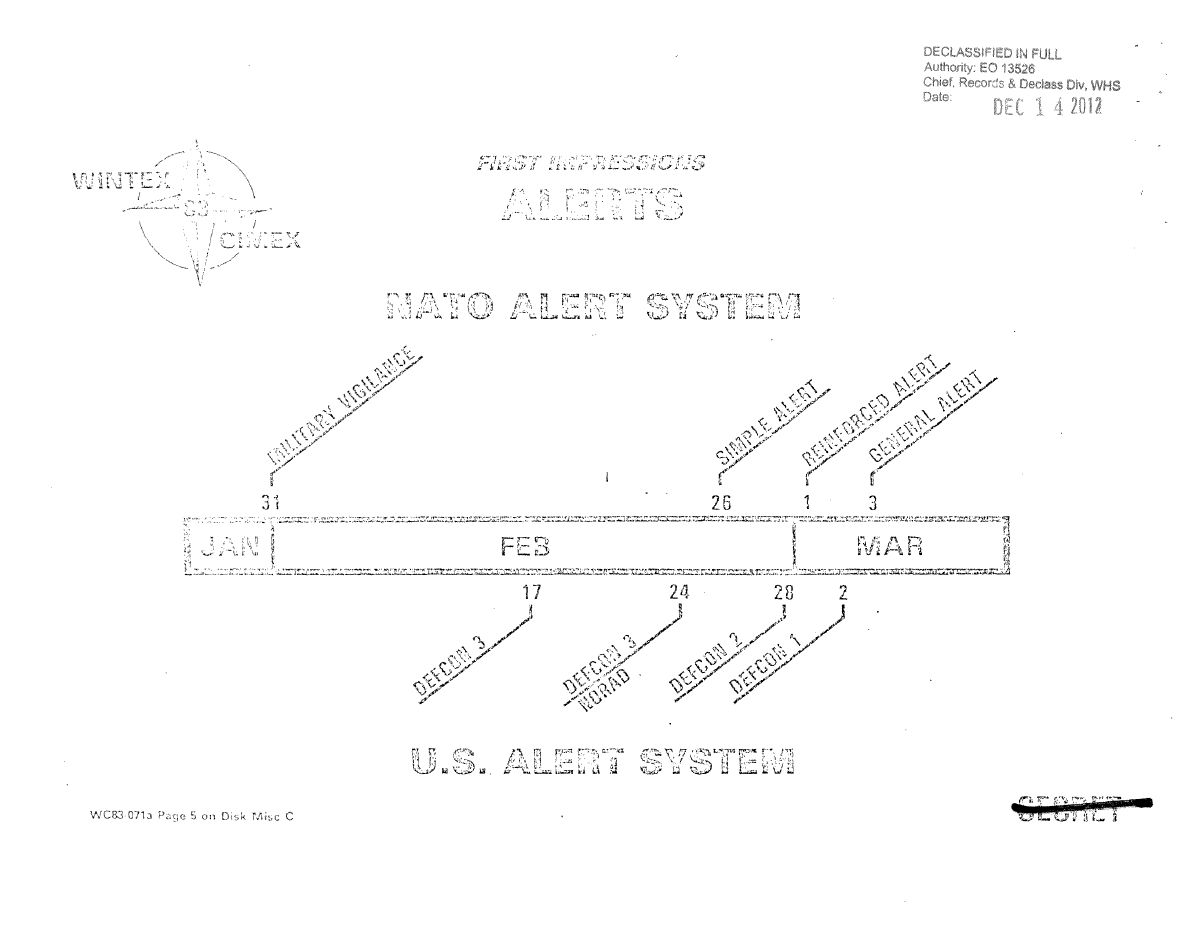 A slide from the Wintex-Cimex 83 exercise illustrates the simulated deterioration from Military Vigilance to DEFCON 1. Document 2: "Notes of WINTEX 83 Senior Level First Impressions Conference, 22 Mar 1983" and related Documents. Source: US Air Force FOIA release. In March 1983, four months after Autumn Forge 82, the US conducted operation Wintex-Cimex 83, a large-scale annual NATO war game — at a similar scale to Autumn Forge — including the "US full reinforcement of Europe," simulated "full mobilization," and culminating in the approval of NATO nuclear release requests and a simulated transition from "military vigilance to "Defcon 1." In March 1983, "senior level" US officials debriefed Wintex-Cimex 83 with an eye towards the next exercise, in the fall of 1983. A primary concern, voiced by the representatives for the Secretary of Defense, was the need for enhanced participation from "higher level players" in Washington DC because, according to General Richard G. Stilwell, "bringing a coalition from crisis to war is demanding. We must continue to practice these exercises." According to a later slide, the "[e]xercise would have benefitted from more political inputs from Washington and more timely response from Washington to political consultations." Electronic communication between the United States and NATO was also difficult. NATO communications equipment rejected forty-eight percent (251 out of 522) of teletype communications sent from the Pentagon to NATO headquarters in Belgium. This was due primarily to "the need for data security differences in national military force structure, doctrine, and tactics." Forebodingly, the slides included a warning that "US nuclear play caused confusion" and an admonition of a "possible lack of adequate control on nuclear procedures."
Document 3: "Autumn Forge 83 - COMALF [Commander Airlift Forces] Briefing," September 9, 1983, Unclassified. Source: History of the 322nd Airlift Division, January 1982 - December 1983, Volume VII Supporting Documents, Prepared by Edgar P. Sneed, Division Historian, Unclassified. Released under the Freedom of Information Act (FOIA). At the onset of Autumn Forge 83, Air Force Lieutenant General Robert F. Coverdale conducted a briefing that provided the Air Force with "an overview of the European theater concept of operations for the Autumn Forge series of exercises," including Reforger 83 and Able Archer 83. Autumn Forge 83 would place an emphasis on the Air Force's use of "highly mobile mini-computers" and "automated data transfers" to "be able to react quickly to changing situations, pass voluminous data between MAC [Military Airlift Command] agencies and our users."
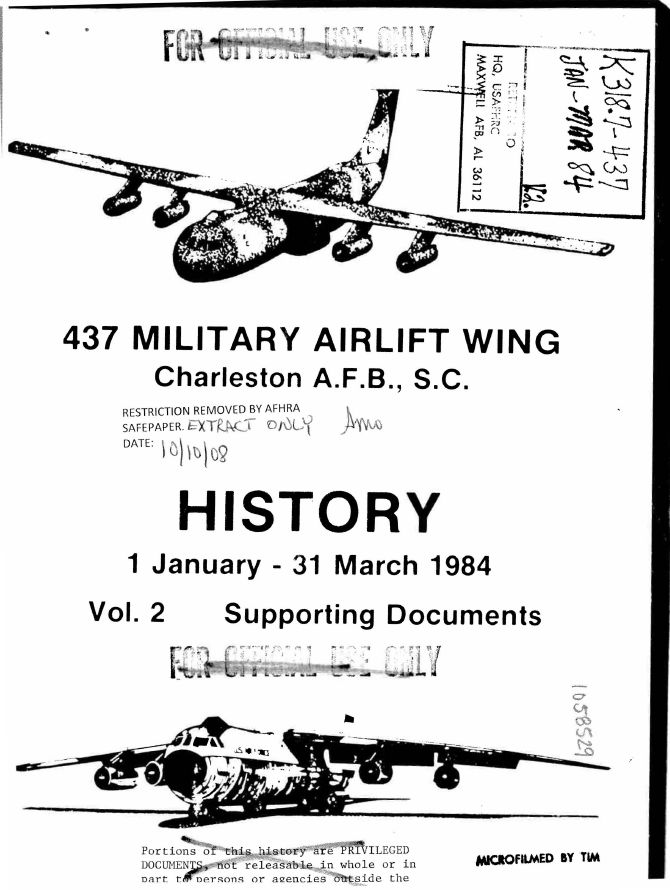 The cover of the Military Airlift Command history recounting that Able Archer 83 deployments to Europe lasted until November 15, 1983. Document 4: "Autumn Forge 83 - Final After Action Report," February 1, 1984, For Official Use Only. Source: 437 Military Airlift Wing Charleston A.F.B., S.C. History: 1 January -31 March 1984 Vol 2. Supporting documents, released under FOIA. The Military Air Lift Command's after-action report states that "Autumn Forge 83 was an umbrella title that included exercises Reforger, Cold Fire, Crested Cap, Display Determination, and Oksoboel." Although the report did not mention Able Archer 83 (Military Airlift Command practiced deploying soldiers only for a conventional war, not for testing nuclear procedures), it does state that its deployments to Europe lasted until November 15. An attached March 1984 Air Man article entitled "For Military Air Lift Command units, the annual Reforger exercise means … Moving the Forces of War," provided a vivid description of Reforger 83 and Autumn Forge 83. Reforger was the largest exercise under the Autumn Forge 83 "umbrella." It consisted mainly of the air lift of 16,044 US troops to Europe (84 percent of the total US troops that participated in Autumn Forge 83). In addition to American soldiers, Air Man reported the massive overarching European war games included "40,000 American, Dutch , German, British, and Canadian military members and tons of equipment." The Air Man article reported that Reforger required eight days of radio silent Atlantic crossings, which delivered more than 16,000 U.S. Army troops to Europe. It also stated that this was the first exercise which used a computer to plot aircraft operations. Maj. Gen. William Overacker, MAC's top general in Europe, described the objectives of Reforger as "both political and military." He also said, "The series of exercises are watched very carefully by the Eastern Bloc nations, just as we try to watch their exercises as closely as we can , to learn tactics and procedures."
Document 5: US Air Force 7th Air Division telegram, "Exercise Able Archer 83 Participation," 23 December 1982 and related "exhibits," Secret. Source: History of the Headquarters, 7th Air Division 1 October 1983 - 31 March 1984, Secret released under FOIA. A Seventh Air Division telegram on the planning of the operation reported on the "apparent shift in exercise objectives" of Able Archer 83 from previous Able Archer exercises to include "quote low spectrum unquote nuclear play exercised as conventional operations continue" (Air Force's wording). Therefore the Strategic Air Command (SAC), based at Ramstein Air Force base in Germany provided a "response cell" to participate in the war game. SAC provided nine officers for Able Archer 83 from five locations (SHAPE, AFNORTH, AFCENT, ERWIN and the UK RAOC). "The primary test of the exercise is to test procedures" not "actual fragging of SAC assets" by the cells, although, "that [did not] preclude Able Archer 83 participants from simulating B-52/KC-135 employment IAW [in accordance with] SACEUR OPLAN 10604 Fancy Girl." Although the details of OPLAN Fancy Girl remain unknown, it was an Air Force commander's plan for operations conducted in a hostile environment, in this case ostensibly against Soviet and Warsaw Pact forces in Europe.
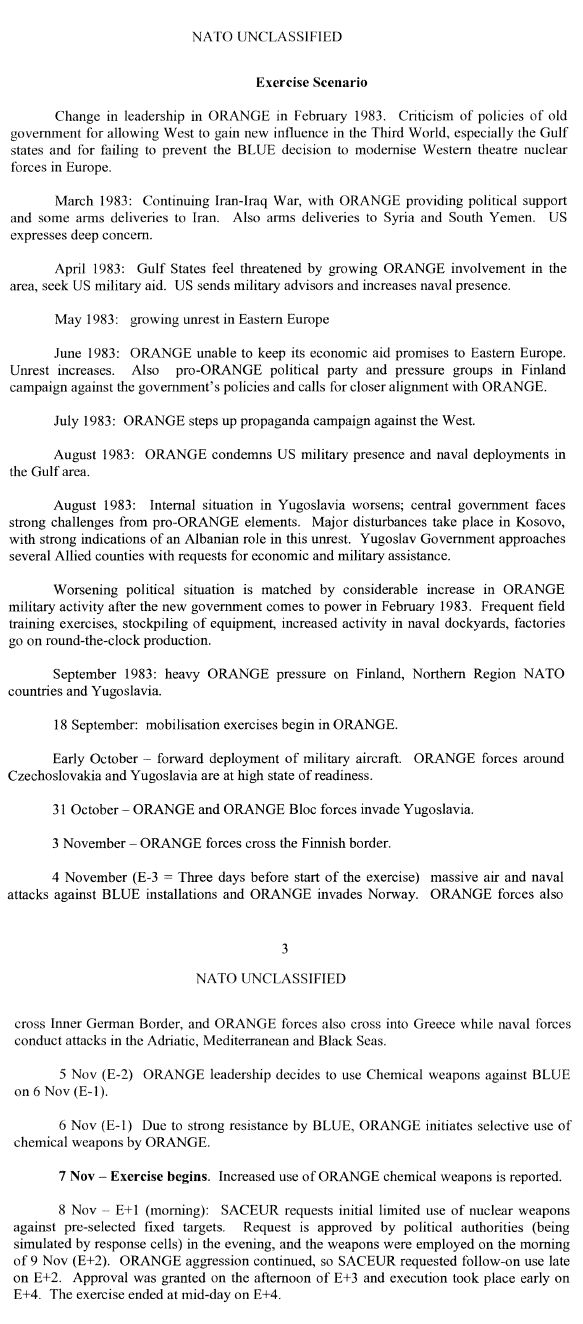 The unclassified NATO summary of Able Archer 83, kindly provided by SHAPE chief historian Gregory Pedlow, provides a chilling narrative of how the Cold War could have turned nuclear. Document 6a: "Exercise Able Archer 83: Information from SHAPE Historical Files,"March 28, 2013, and Document 6b: "Exercise Scenario," Undated, NATO Unclassified Source: Kindly provided by SHAPE chief historian Gregory Pedlow. SHAPE recently produced an unclassified six-page summary of Exercise Able Archer 83 in response to requests from researchers, in order to summarize the still-classified record. As the specifics of Able Archer 83 have been the subject of 25 years of mystery, conjecture and speculation, the SHAPE report deserves extensive quotation: "Exercise Able Archer was held from 7-11 November 1983. It was an annual Command Post Exercise (thus involving only headquarters, not troops on the ground) of NATO's Allied Command Europe (ACE), and it was designed to practice command and staff procedures, with a particular emphasis on the transition from conventional to non-conventional operations, including the use of nuclear weapons. Overall responsibility for the exercise lay with the Supreme Command Allied Powers Europe (SACEUR). The participants in the exercise were SACEUR's own headquarters SHAPE (Supreme Headquarters Allied Powers Europe), its immediate subordinate headquarters known as Major Subordinate Commands, their subordinates known as Principal Subordinate Commands, and other lower-level War Headquarters throughout ACE ... " "The exercise scenario began with Orange (the hypothetical opponent) opening hostilities in all regions of ACE on 4 November (three days before the start of the exercise) and Blue (NATO) declaring a general alert. Orange initiated the use of chemical weapons on 6 November and by the end of that day had used such weapons throughout ACE. All of these events had taken place prior to the start of the exercise and were simply part of the written scenario. There had thus been three days of fighting and a deteriorating situation prior to the start of the exercise. This was desired because — as previously stated — the purpose of the exercise was to test procedures for transitioning from conventional to nuclear operations. As a result of Orange advance, its persistent use of chemical weapons, and its clear intentions to rapidly commit second echelon forces, SACEUR requested political guidance on the use of nuclear weapons early on Day 1 of the exercise (7 November 1983)…" "Blue's use of nuclear weapons did not stop Orange's aggression. Therefore, SACEUR requested follow-on use of nuclear weapons late on 9 November. This request was approved in the afternoon of 10 November and follow-on use of nuclear weapons was executed on the morning of 11 November. That was the final day of the exercise, which ended in accordance with the long-planned schedule." The summary also lists the units whose headquarters participated in Able Archer 83. Response cells from the United States, United Kingdom, and NATO (no other nations) participated in the exercise. The Joint Chiefs of Staff in the US and Ministry of Defense in the UK participated "with small response cells." The NATO response cell was simulated by the Exercise Directing Staff. The NATO summary concludes by stating the historian interviewed "a number of senior participants in Exercise Able Archer 83" in 2006 and that "none of them recalled any 'war scare' or even unusual Soviet reaction to the exercise. Air Chief Marshal Sir Peter Terry, the Deputy SACEUR who played the role of SACEUR during Able Archer 83, stated quite categorically that 'no such scare arose at that time.'" The summary does not mention or refute the accounts published in the CIA's Studies in Intelligence or the May 1984 Special National Intelligence Estimate which reported the "Assumption by Soviet air units in Germany and Poland from [date redacted] November 1983 of high alert status with readying of nuclear strike forces as NATO conducted 'Able Archer 83' a nuclear release command post exercise."[3] The Archive's third and final War Scare posting will included declassified US Department of State documents showing that the US "sanitized" (removed) references to these Soviet responses to Able Archer 83 in the intelligence reports they shared with their NATO allies. To SHAPE, the Soviets were "huffing and puffing" (to borrow President Reagan's phrase) in late 1983, and were not genuinely afraid of a NATO nuclear first strike.
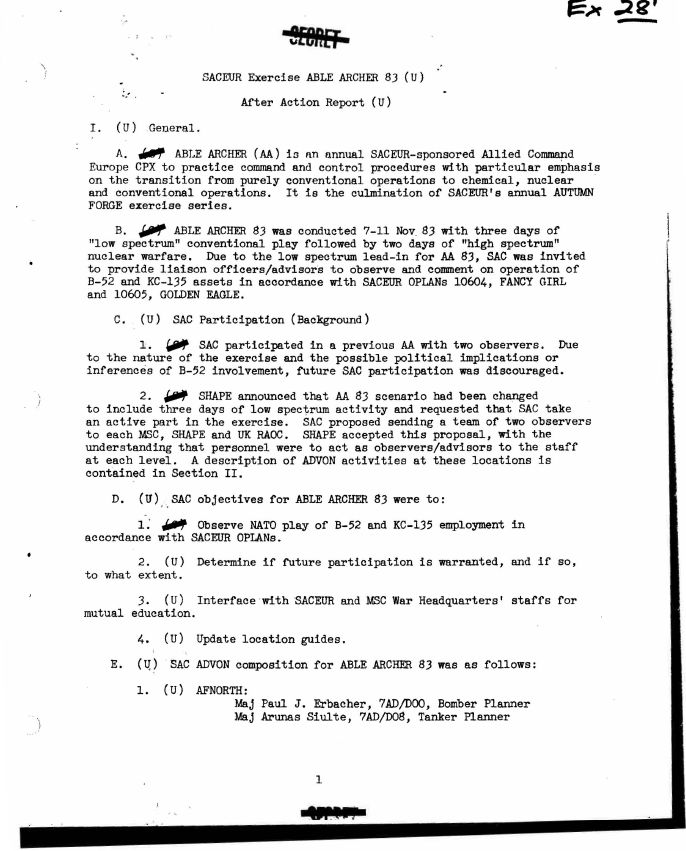 The December 1, 1983, "Exercise Able Archer 83 After Action Report" provides details of the war game that spanned from Norway to the Crimea. Document 7: Air Force Seventh Air Division, Ramstein Air Force Base, "Exercise Able Archer 83, SAC ADVON, After Action Report," December 1, 1983, Secret NOFORN. Source: US Air Force FOIA release. The March 2013 SHAPE summary (see previous document) reports that "few further details are available on the actual course of the exercise — the various incidents that were simulated, the messages sent/received — because this kind of exercise material was not preserved in the archives." Fortunately, a recently declassified 17-page after-action report prepared by the Seventh Air Division provides a thorough summary of the "on the ground action," as reported by aircrews during Able Archer 83. The report elaborates on the SHAPE summary, describing three days of "low spectrum" conventional play followed by two days of "high spectrum" nuclear warfare. "Due to the low spectrum lead-in for AA 83, SAC was invited to provide liaison officers/advisors to observe and comment on the operation of B-52 and KC-135 assets in accordance with SACEUR OPLANs 10604, FANCY GIRL and 10605, GOLDEN EAGLE." The details of 10605 GOLDEN EAGLE remain unknown, but like FANCY GIRL (see above) constitute Air Force plans for operations in a hostile environment.[4] The after-action report confirms that the war game spanned from Norway (low altitude attacks on the Kola Peninsula would have been more effective than high altitude attacks) through Germany ("Orange Forces were attacking along the entire German border with air attacks"), to the United Kingdom ("OR attacks on UK airfields disrupted B-52 and KC-135 operations as well as destroying some aircraft"), Bulgaria (a coordinated B-52 and Fighter attack on Verna and Burgas airfields), and the Crimea (F-111 attacks). The SHAPE summary states that "one of the things that was practiced during the exercise was shifting command from Permanent War Headquarters to the Alternate War Headquarters" and that "there was apparently some movement into the field." The Air Force's after-action report fills in these gaps. "Orange conducted chemical attacks throughout the exercise," the Air Force report states. Because of this, war gamers "were directed to go to the Alternate War HQ (CREST-HIGH)" at Heinrich Hertz Kaserne in Birkensfeld. There, "helmets, gas masks and chemical suits" were worn by actors. The Blue side also utilized "unconventional warfare personnel" which were "inserted" into Orange target areas to pass information to war planners to pass "updated DMPI" (designated mean point of impact, that is, targeting data) to war planners for "the maximum effectiveness of the sortie." "Beacon bombing"(presumably rather than conventional "radar bombing") was also discussed, but not used. At one point, on November 11, eight KC-135 Stratotankers in the United Kingdom were "launched for survival," likely in response to a simulated Orange nuclear attack. The SHAPE summary states that Blue conducted a simulated nuclear attack that same day. The key difference between the SHAPE summary and the Air Force after-action report is the NATO summary's omission of the fact that Able Archer 83 was the finale of a simulated land war in Europe, including as many as 40,000 troops (19,000 Americans). This was apparent to the Air Force, which called Able Archer the "culmination" of both Autumn Forge 83 and Reforger 83. While actual troops and units did not participate in Able Archer 83, they certainly did in the conventional war games simulating a land war in Europe, the "culmination" of which was Able Archer 83's simulated nuclear release. Importantly, the after-action report states that there was "a SACEUR decision" before the beginning of the exercise "to reduce the level of nuclear exchange between Blue and Orange." The after-action Report does not disclose the reason why SACEUR decided to reduce the nuclear exchange element of the exercise; the SHAPE summary states that "because the exercise scenario began at a low crisis level, there was actually less nuclear play than in previous years." The after-action report includes one startling observation: "The presence of the SAC ADVON [an advance echelon vanguard], especially in large numbers for an exercise of this nature, raises a sensitive, political issue concerning the role of the B-52. One may see an implication or make the inference that if B-52 aircraft are present in a nuclear scenario exercise, are they being used to perform strike missions? Numerous times during the exercise the word "strike" was used in reference to B-52 sorties. While this is an obvious slip of the tongue and was quickly corrected, in most cases, it does serve to fuel any inference should a remark be made in a nonsecure environment. A large, if not fully manned, ADVON team which would be required to properly support ABLE ARCHER, being deployed to the many locations would only again give rise to speculation about the B-52 role."
Document 8: KGB Headquarters Moscow to the London KGB Residency, "Ref no. 1673/PR of 24.10.83," November 5, 1983, Top Secret. Source: Christopher Andrew and Oleg Gordievsky, Comrade Kryuchkov's Instructions: Top Secret Files on KGB Foreign Operations, 1975-1985, (Stanford: Stanford University Press 1991) 86-87. The primary source for the British and American intelligence agencies' attention to the War Scare was MI6 asset Oleg Gordievsky, who became a KGB rezident in London in June of 1982. He reported that the Soviet leadership may have feared an imminent attack during Able Archer 83. (The CIA's discussion of his bona fides is included in the previous EBB in this series.) Gordievsky also became an important source for historians studying the War Scare. He worked with British historian of intelligence Christopher Andrew to write several books, which included key Soviet documents and shared his recollections of the War Scare, Operation RYaN, and Able Archer 83 after his 1985 defection.[5] According to the documents published by Gordievsky, on November 5, 1983, Moscow Center sent the London residency a telegram that opened by stating, "In response to your request we are sending you the information which the Centre has regarding possible Operations by the USA and its allies on British territory in preparations for RYaN." [6] The telegram continued, "surprise is the key element in the main adversary's [United States'] plans and preparations for war in today's conditions. As a result it can be assumed that the period of time form the moment when the preliminary decision for RYaN is taken, up to the order to deliver the strike will be of very short duration, possibly 7-10 days." The Center instructed agents to monitor "possible contacts and consultations between the United States government and British leadership," (including at 13 Ministry of Defense buildings), and warned them to watch for "announcements of military alert in units and at bases," and the "appearance of new channels of communications." The beginning of Able Archer 83 included at least some of these indicators. Presumably an apt intelligence officer would have concluded, as did Gordievsky, that despite these indicators Able Archer 83 was in all likelihood a nuclear drill. Then, Gordievsky writes, on November 8 or 9, he "was not sure which," flash telegrams were sent to both KGB and GRU residencies in Western Europe reporting "an alert on US bases."[7] The flash telegrams "clearly implied that one of several possible explanations for the (non-existent) alert was that the countdown to a nuclear first strike had actually begun." According to the SHAPE summary, the morning of November 8 was when SACEUR requested "initial limited use of nuclear weapons against pre-selected fixed targets. Request [was] approved by political authorities (being simulated by response cells [including "small cells" in the UK and US]) in the evening, and the weapons were employed on the morning of 9 November." Of course, there were no plans for a Western first strike. But as General Secretary Yuri Andropov told the US envoy Averell Harriman in June 1983, the tense relations between superpowers (and six-minute nuclear response times) meant that the miscalculation of a nonexistent attack could still present a genuine danger. Additionally, Soviet military doctrine held that a nuclear attack could be effectively obscured by war games or military exercises.[8]
Document 9: US Air Force Military Airlift Command "Reforger 83\Crested Cap 83\Display Determination 83\Autumn Forge 83 After Act Report," December 8, 1983, Confidential. Source: History of Military Airlift Command: 1 January - 31 December 1983: Supporting Documents Volume IX, Confidential. Released under FOIA. The Military Airlift Command's after-action report tells that 19,000 troops and 1,500 tons of cargo were sent to Europe over the course of 172 missions during Autumn Forge 1983. Of these, 16,044 troops were deployed during Reforger 83. As Able Archer 83 was conducted, a "surge" of military personnel had created a significant addition to the NATO foot print in Europe.
Document 10: Commander in Chief, United States Army, Europe (CINCUSAREUR) "Reforger 83 After Action Report," March 6, 1984, Confidential. Source: Department of Defense, Washington Headquarters Services, Mandatory Declassification Review release. CINCUSAREUR's 200-page after-action report of Reforger 83 states that it was the fifteenth Reforger exercise, and provides a comprehensive list of the units that participated. The major participants were the 3rd US Corps Battle Staff; 1st Cavalry Division, 3rd Armored Cavalry Regiment; 1st Battalion, 75th Infantry (Ranger); and the 1st Battalion, 198th Armor (MS ARNG) [Mississippi National Guard]. The report also states that 27 people observed Reforger 83 under the provisions of the "Confidence Building Measures" provision of the Helsinki Pact of 1975, but does not report which countries these observers were from.
Document 11: US Air Force History of the Headquarters, Seventh Air Division 1 October 1983 - 31 March 1984, Narrative, by Charles E. Arnold, TSgt, USAF Historian, September 20, 1984, (Excerpt) Secret. Source: US Air Force FOIA release. The official history of the headquarters of the Seventh Air Division, based at Ramstein Air Force base in West Germany, links Able Archer 83 to Reforger 83, stating "the annual SACEUR-sponsored Exercise Able Archer … culminated the large scale Reforger series of live exercises and emphasized the transition from conventional to chemical and nuclear operations." The history also notes that Able Archer 83 was different from past exercises because it included "a newly developed conventional build-up portion." Despite this "conventional build-up portion," the SAC history records that Able Archer 83 "remained primarily a nuclear procedures exercise."
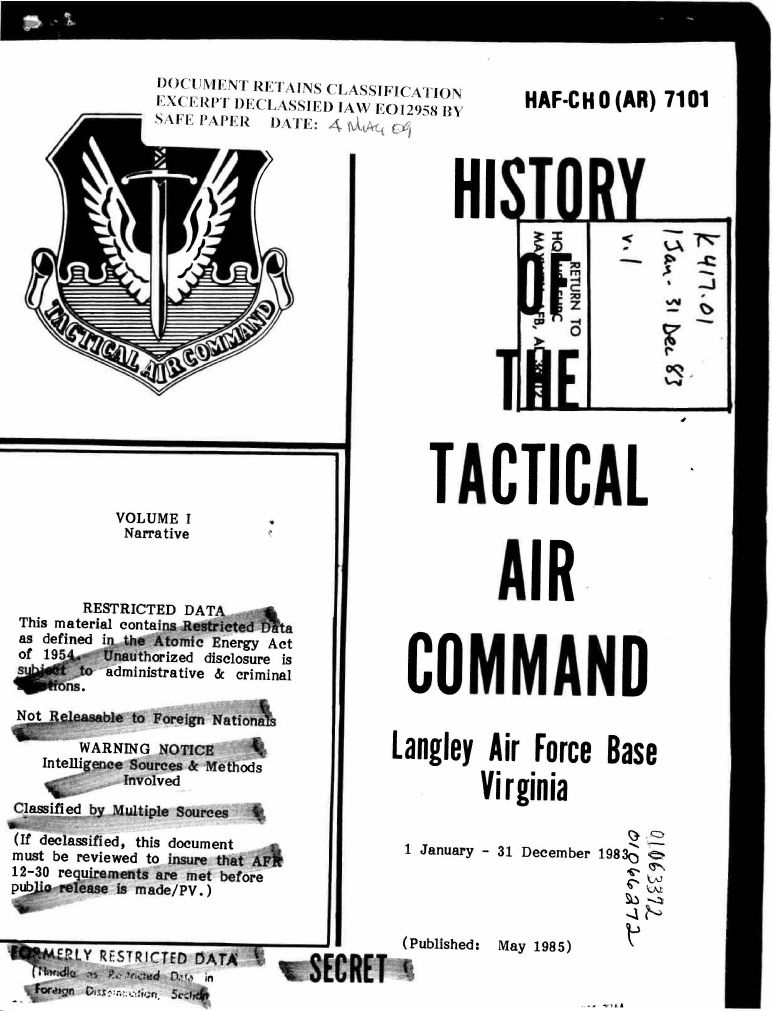 The History of the Tactical Air Command catalogs the Tactical Air Command's response cells' participation in Able Archer 83. Document 12: History of the Tactical Air Command, Langley Air Force Base, Virginia: 1 January - 31 December 1983, Volume I Narrative, May 1985, Secret. Source: US Air Force FOIA release. The Tactical Air Command also participated in Able Archer 83. Its history states that on November 7 "Able Archer 83, a JCS-coordinated, USCINCEUR-sponsored CPX to practice command and staff procedures, was initiated at various command posts. TAC response cells participated." No other Tactical Air Command documents have been released. The Navy and Army also participated in Able Archer 83 ( including elements of the III Corps battle staff, 1st Cav Div, 3rd ACR, 1 st BN 75 Rangers), but unlike the Air Force or Department of Defense Washington Headquarters Services, those DOD components have not yet provided documents in response to FOIA requests.
Document 13: U.S Congress, House of Representatives, Hearing before the Defense Subcommittee of the Committee on Appropriations, Department of Defense Appropriations for 1986, Ninety-Ninth Congress, First Session, March 27, 1985, Unclassified. Source: Congressional Record. During a March 27, 1985 congressional hearing, USAF Brig. Gen. Mark J. Worrick provided the subcommittee with information on the Air Force's operations and maintenance costs. Among his evidence was a list of JCS-directed and coordinated exercises and their associated costs that were submitted for the FY85/FY86 President's Budget. The list also provides the budgeted and actual costs for FY84 exercises, and notes that in FY84 Able Archer 83 cost $111 million, and Reforger 83 cost $2.407 billion, for a total of $2.518 billion.
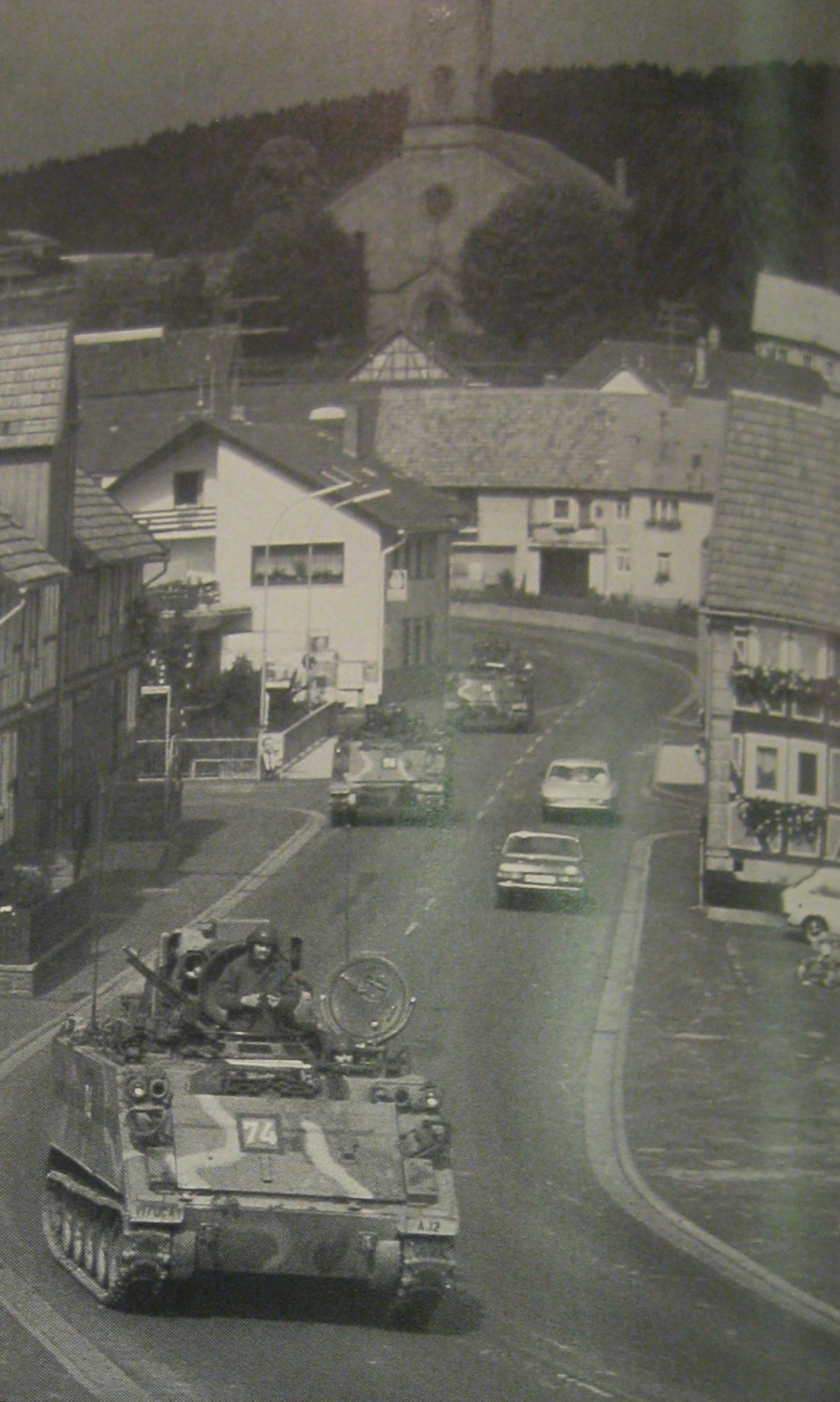 Three of the 3,500 tanks and armored personnel carriers used during Autumn Forge roll through Stockhusen, Germany, from Air Man. Document 14: Unpublished Interview with former Soviet Head of General Staff Marshal Sergei Akhromeyev, January 10, 1990. Source: Princeton University, Mudd Manuscript Library, Don Oberdorfer Papers 1983-1990, Series 1, Soviet Interviews, 1990. This interview between Washington Post journalist Don Oberdorfer and the former head of the Soviet General Staff, Marshal Sergei Akhromeyev, exposes a key historiographical problem in the study of the "Able Archer 83" War Scare. The NATO exercise was not known as "Able Archer 83" to Soviet intelligence as it was being conducted. Soviet analysts have referred to it as "Autumn Forge 83," the name for the larger, months-long, umbrella exercise of which Able Archer was the conclusion. The US military establishment usually referred to Able Archer 83 as "Reforger 83," the name for the military lift operation at the end of "Autumn Forge 83" where the US moved its troops to Europe to prepare for a conventional war. According to the declassified Military Airlift Command after-action report included in this EBB, 16,044 of the 19,000 troops deployed to Europe for Autumn Forge 83 (84 percent) were deployed during Reforger 83. "Able Archer 83" was in fact the NATO command post nuclear exercise at the tail end of both Autumn Forge and Reforger.[9] Both exercises "culminated" when a conventional land war with the "Orange Pact" over Europe turned nuclear. In a key exchange of this 1990 interview, Akhromeyev tells Oberdorfer that he did not remember "Able Archer 83" but that "we believed the most dangerous military exercises are [were] Autumn Forge and Reforger. These are [were] the NATO exercise in Europe." While Akhromeyev states that he felt no "immediate threat of war," he adds: "I must tell you that I personally and many of the people that I know had a different opinion of the United States in 1983 than I have today [1990]. I considered that the United States is [was] pressing for world supremacy … And I considered that as a result of this situation there can [could] be a war between the Soviet Union and the United States on the initiative of the United States." [10]
Document 15: Unpublished Interview with former Secretary of Defense Caspar Weinberger, October 18, 1989. Source: Princeton University, Mudd Manuscript Library, Don Oberdorfer Papers 1983-1990, Series 3, Research Documents Files. In an interview with Don Oberdorfer, former Secretary of Defense Caspar Weinberger said that Able Archer 83 "involved the timing of the release of nuclear weapons, the chain of command -who would have the authority, how quickly could it come back here and go back over there-all that sort of thing. It was a standard exercise." He does, however, lend credence to Soviet Marshal Akhromeyev's feeling that these large military exercises -specifically Autumn Forge and Reforger- were "the most dangerous." "But I do remember," Weinberger continued, "and I do know, because I felt the same way on our side - that it is sometimes quite difficult to tell the difference between an exercise and the beginning - the raising of indicators that we watch all the time every day, every hour." He cited his anxiety over a North Korean exercise because: "they were moving a hell of a lot of stuff in position and everybody knew it was just a maneuver and it was an annual exercise, but I got quite alarmed, because I kept saying 'What if it isn't? We've lost about five days of time.' So the difference between a realistic exercise or maneuver and what could be preparations for an attack, that line is sometimes quite blurred."
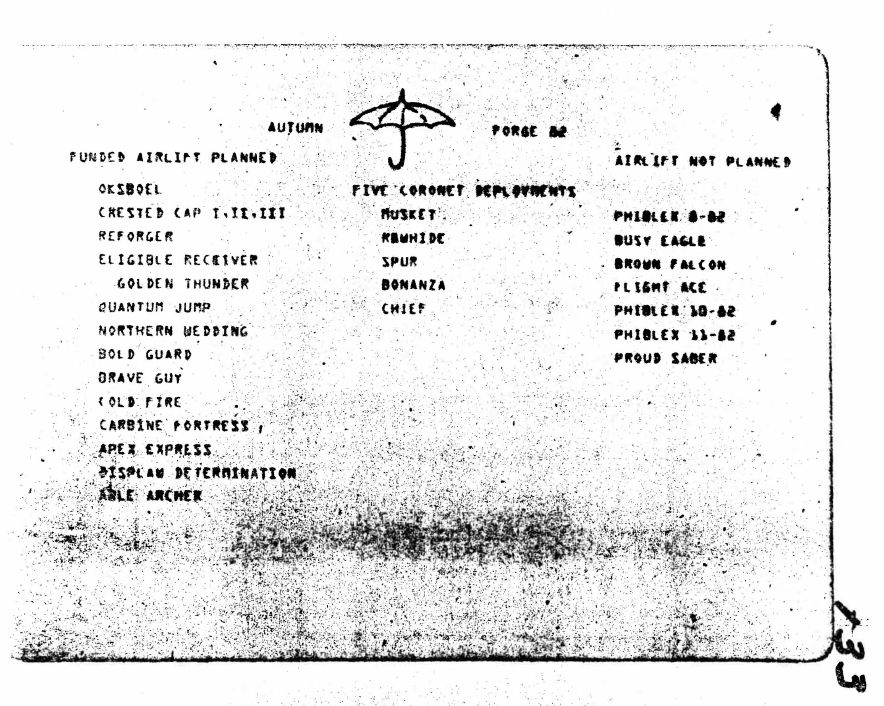 A slide from the unclassified September 9, 1983, commander airlift forces briefing illustrates the umbrella nature of the Autumn Forge 82 exercises. Document 16: Unpublished Interview with former National Security Advisor Robert McFarlane, undated but in 1989 or 1990. Source: Princeton University, Mudd Manuscript Library, Don Oberdorfer Papers 1983-1990, Series 3, Research Documents Files. McFarlane describes the nuclear aspect of Able Archer 83 to Oberdorfer as "very rare … We've always had Reforger and Crested Cap for a generation. But this kind of thing where you go through the escalatory steps to general war — I don't remember any since the '60s in fact." McFarlane also repeated the controversial claim that someone, "probably Vic Boverie and the Defense people … rais[ed] a concern that in the context of other reports we had had of anxiety on the part of the Russians, that for us to conduct an exercise like this with principals in place could be alarming. And I thought that was a valid concern." McFarlane continued: "And I talked to Cap [Weinberger] about it and Cap agreed that there ought to be some very obvious missing players and other ways of telling that this was clearly an exercise, and did [that]. And there were, I think if you'll check back, some folks, notably the President, Vice President and the Chiefs [who did not participate], one of the commanders in EUCOM wasn't playing." This assertion has received much push back. In his interview, Weinberger stated that "I don't remember anything about that. McFarlane's memory — I guess the kindest way to phrase it — exceeds mine in many instances."[11] Documents the National Security Archive has obtained mention only the participation of a "small" Joint Chiefs of Staff cell in Washington, though the Seventh Air Division's after-action report of Able Archer 83 did note, "a SACEUR decision … to reduce to the level of nuclear exchange between Blue and Orange." This and many other questions will likely not be resolved until the declassification of additional materials known to exist. One notable items is the comprehensive President's Foreign Intelligence Advisory Board report on the War Scare, authored by Nina Stewart, which continues to languish at the George H. W. Bush Presidential Library, despite being requested under FOIA by the National Security Archive in 2004 — a victim of our nation's broken declassification system.[12]
Document 17: Office of the Secretary of Defense, Memorandum From Deputy Assistant to the President for National Security Affairs, "Subject: Significant Military Exercise NIGHT TRAIN 84," December 8, 1983, Secret. Source: Reagan Presidential Library, Jack Matlock Files, b. 2 [90888], f: "Matlock Chron Dec 1983 (1 of 2) . A coda to the declassified descriptions of Exercises Autumn Forge 83, Reforger 83 and Able Archer 83 is this December 8, 1983 memo from General Colin Powell, then military assistant to the Secretary of Defense. Powell was writing about the upcoming US-Canadian military exercise Night Train 84, conducted from 5-13 April 1984. In his memo, Powell warned, "Conduct of a worldwide nuclear exercise could show strength of purpose. On the other hand, it could be perceived as showing an intent for use of nuclear weapons. It could have the potential to affect US/USSR strategic arms reduction negotiations or bilateral US/USSR strategic arms reduction negotiations or bilateral US/USSR summit preparations should either of these be in progress." No analogous brief has been found for Autumn Forge 83, Reforger 83, or Able Archer 83. The final War Scare Electronic Briefing Book will present the US intelligence community's analysis of the 1983 episode, including three declassified reports composed in the aftermath of Able Archer 83 in which the intelligence agencies, which had previously largely concluded that Soviet political and military leaders were "huffing and puffing" and did not genuinely fear war with the United States, now began to recognize "a dimension of genuineness to the Soviet expressions of concern."
NOTES[1] Christopher Andrew and Oleg Gordievsky, Comrade Kryuchkov's Instructions: Top Secret Files on KGB Foreign Operations, 1975-1985, (Stanford: Stanford University Press 1991), 86. [2] C3 appears to refer to the NATO definition of "consultation, command, and control" rather than the DOD definition of "command, control, and communications." [3]The next War Scare Electronic Briefing Book will focus on US Intelligence Community analyses of the War Scare. [5] Gordievsky incorrectly identifies the date that Able Archer began as November 2, 1983, rather than November 7, 1983, as reported by the US Air Force after-action reports. More recent research has asserted Able Archer 83 began on November 4, 1983, but this is also incorrect. Gregory Pedlow, chief historian of the SHAPE historical division, confirms that Able Archer 83 began on November 7, 1983. There was however, "a written scenario (not part of the actual exercise) which began on 4 November 4with Orange's use of chemical weapons." [6] Importantly, this document — unlike others reproduced in the book — does not include a Russian facsimile. It is typeset and translated into English with no Russian corroboration of authenticity. [7] Regrettably, no text of the November 8 or 9 flash telegram has been released or reproduced. Gordievsky's revelation of this warning is the only basis for the current historical record (though the preceding and following telegrams which he reproduced and published do serve as somewhat sturdy bona fides). [8] A. A. Sidorenko, The Offensive (A Soviet View) (Washington DC: US Government Printing Office, 1970), 115. The United States also feared that exercises could be used as "ruses of war." See Caspar Weinberger interview in this EBB. [9] See also, Colonel L. V. Levadov, "Itogi operativnoi podgotovki obedinennykh sil NATO v 1983 godu" (Results of the Operational Training of NATO Joint Armed Forces in 1983," Voyennaya Misl' (Military Thought), no. 2 (February 1984). [10] This (and other) Soviet statements of alarm at least partially contradict the assertion of Vojtech Mastny (and others) that, "[n]o high-ranking Soviet official in a position to know, including such a key figure as the first deputy chief (and later chief ) of the Soviet General Staff Marshal Sergei F. Akhrome[y]ev, has been found who remembers any alarm being raised because of the NATO exercise." See Vojtech Mastny, "How Able Was 'Able Archer'? Nuclear Trigger and Intelligence in Perspective," Journal of Cold War Studies, Volume 11, Number 1, Winter 2009, 119. Marshal Akhromeyev did keep a journal that is not currently available to researchers. [11] Gregory Pedlow, chief SHAPE historian, wrote that "There was … no involvement of national leaders in the exercise, and no such involvement was ever planned, despite some recent allegations to this effect." [12] The report is stored at George H.W. Bush Presidential Library, Presidential Records, PFIAB, folder title: "Reports to the President - War Scare Report 1990," OA/ID box number is CF01830-020. The Library has been of assistance in trying to win this document's release, but its continued unavailability reflects on the state of declassification today. In this case, the problem lies with an "unnamed agency" that will not allow the Library (part of the National Archives and Records Administration) to perform a declassification review, despite that "unnamed agency" failing to complete its own review since the National Security Archive requested the document in 2004. In 2012, the National Security Archive asked the "FOIA Ombudsman," the Office of Government Information Services (OGIS), for help in determining the name of the "unnamed agency" negligent in reviewing the document. But OGIS seemed to support the contention that an agency reviewing a decades-old document could remain anonymous, writing that, "In exceptional circumstances, when a referral pertains to the involvement of an intelligence community agency and the involvement of that agency is itself classified, the name of the agency may be withheld under Executive Order 13526 regarding Classified National Security Information …Your case involves a classified document and, as such, appears to fall into these exceptional circumstances." Because we do not know the name of the agency which is stymieing this document's declassification, the National Security Archive is anxiously waiting for this case to come before the Interagency Security Classification Appeals Panel (ISCAP), housed at NARA, which we sometimes call (in the spirit of gallows' humor) "the secrecy court of last resort." Fritz Ermarth, the primary author of the CIA's 1984 initial Special National Intelligence Estimate on the War Scare has written, "If it hasn't already been, [the PFIAB] report should be declassified as much as possible ... the historical work done since then suggests [it] had a point, and it is worth pursuing further." (See Fritz Ermarth, "Observations on the " War Scare of 1983 From an Intelligence Perch," for the Parallel History Project on NATO and the Warsaw Pact, November 6, 2003.) The next War Scare posting will include an interview with one of this elusive PFIAB report's authors, describing the content and conclusions of the report.
|
The 1983 War Scare: "The Last Paroxysm" of the Cold War Part IIPart II: "Blue's use of nuclear weapons did not stop Orange's aggression."Able Archer 83 DeclassifiedNational Security Archive Electronic Briefing Book No. 427PART 2 OF 3 POSTINGSPosted – May 21, 2013 Edited by Nate Jones For more information contact: |

